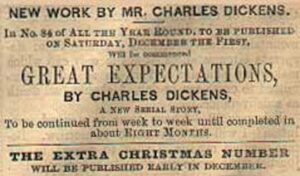Serial Literature

Streaming literature has a very rich history and a plausibly bright future, each for it’s own reason. The former because the price was right; the latter because it fits the contemporary attention span.
The great novelists of the 19th century, Dumas, Flaubert, Thackeray, Eliot, and especially the “father” of the form, Charles Dickens, produced their classic works serialized in the literary journals and magazines of the time. The expansion of literacy that followed the advent of the printing press produced a willing audience, but books were expensive and beyond the means of many potential readers. Serial versions not only were affordable but they allowed publishers to gauge the popularity of a work before committing to publishing it in book form. HERE

illustration: Ralph Steadman
Although it continued into the 20th century, serialization of literature lost favor even as the serial form gained popularity in radio and television. Fiction became the purview of broadcast media and printed periodicals came to focus on news and information. HERE
Television owes more to serial literature than most of us recognize, and that burgeoning creativity of television serials may spark a resurgence of episodic publications. One feeds the other rather neatly. Stories driven more by character than plot and with more flexibility to change on the fly would seem to be once again attuned to the times, if for different reasons than the era in which Henry James and Arthur Conan Doyle plied their trade. HERE

Serial literature is poised to make a come back. Attention span being what it is in contemporary life – short, in a word – and digital devices offering a different reading experience, one that can be situational. The episodic construct for presenting literature may succeed for the same reason streaming television series does: it is bite-sized, convenient, versatile. Stories told in 3,000 word installments weekly are more approachable than tackling a 900 page tome in one volume. Wading in waters weekly with characters you come to know over time may be preferable to a reckless plunge into that deep pool of the fathomless novel lurking at one’s bed stand. Who among us has the time today even to tackle that sentence, let alone the entire paragraph that houses it? Instead, let’s keep it short. More HERE

All of which leads to the subject at hand, a new service from Kindle Vella for serializing novels and a book I’m writing called Cascadia: A Future Fable of Destruction and Redemption by James Pagliasotti. It was begun in the aftermath of electing an incomprehensible president in November 2015. Here’s the blurb about the novel:
What does it take to step back from our everyday lives and completely rethink the way we live? Political upheaval, climate crises, drought, wildfires, a global pandemic; all of them have come our way and life goes on pretty much unchanged. But what if our economy was undone? What if our communities were destroyed and all the systems that sustain them were disconnected? What if our national government abandoned us and left us to fend for ourselves? What would matter to us then and what choices would we make about how to lead our lives? This story starts with a catastrophe so destructive that every aspect of “normal” life is challenged and startling decisions about how to go forward are engaged. The United States comes undone, Cascadia comes to be, and the two nations that rise from that dissolution quickly find themselves on a collision course. War is inevitable. Will the old ways prevail or the new order find a better way to live?
The first three episodes are available now HERE and the next 20 some episodes to be presented weekly are already in the hopper. I’d love to know what you think of it and meanwhile I’ll keep writing until the end of this saga appears somewhere off in the future.